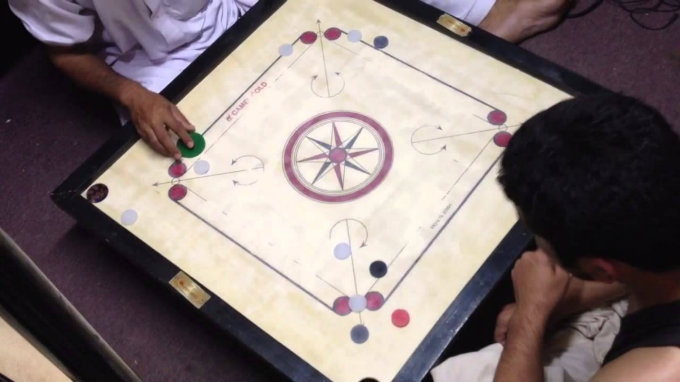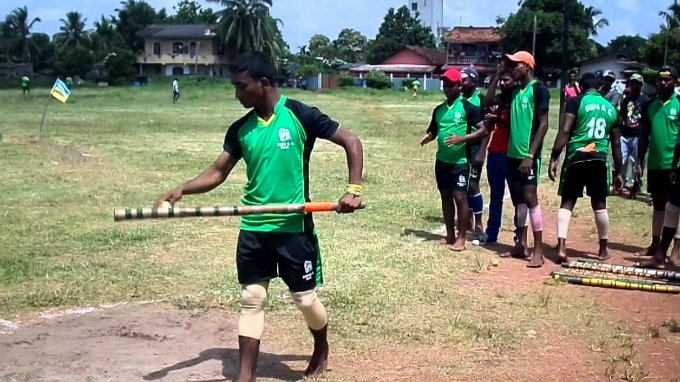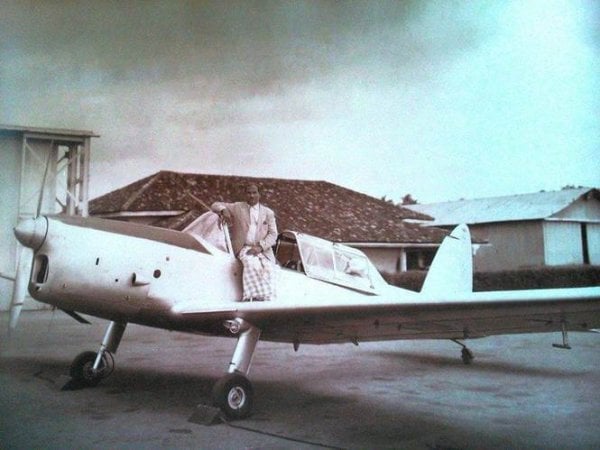
Hopscotch, carrom, walla salli and tin kadanawa. These are a handful of the indoor and outdoor games that were enjoyed by local children, in a time before video games became as popular as they are now. Games like elle are unique to our culture, while others—like hopscotch—are played elsewhere, too.
Hopscotch

Hopscotch or batta is played by drawing a grid of nine squares in the sand or on a hard surface. Image courtesy playbuzz.com
Better known as batta in Sinhalese, this game was schooltime favourite. The game is centred around a grid of nine squares which was drawn in the sand or chalked on a floor. Any number of players can take part, but only person was allowed to use the grid at a time. The grid consists of three single squares, a double square, another single square and finally another double square—each of the squares were marked with a number between one to nine.
To play the game, each player would take turns tossing a flat stone onto the first square, then hop on single foot onto the second square, picks up the stone and toss it onto the next one. The game proceeds in this manner unless a player tosses the stone onto a wrong square or a line between the squares—then it is the next player’s turn.
A variation of this game is a rectangular two-columned grid of three or four squares per column. The players of this game would hop on foot from the first square to the eighth square, while gently kicking each stone onto the next square.
Athuru Mithuru
athuru mithuru dhama divathuru
raja kaputu hettiya
alutha gena manamalita
hal pothak garala
ihala getath bedhala
pahala getath bedhala
kukula kapala wata mulle
kikili kapala dora mulle
athak ganning hettiyo!
Athuru mithuru was a song game played among small groups of children. They would sit on the ground, keep their fingers splayed and hold each others hands. One of the children would then begin singing the ‘athuru mithuru’ rhyme and count each of the participant’s hands. The hand which was counted at that the end of the rhyme would be withdrawn, and the rhyme would be sung from the beginning again. The game ends when all of the children’s hands have been withdrawn.
Tin Kadanawa
In Sinhalese, the name of this game literally means ‘breaking tins’. A number of tins were stacked on of top of each other to make a tower of sorts. Then a member of one group of children would break the tins by tossing a ball—usually tennis ball—at the stack of tins. Then a second group of children would try to quickly put the stack back together, while the first team would try to stop them from doing so by throwing the ball at each of their feet.
Those who were hit with the ball were out of the game. If the first team succeeded in knocking all members of the other team out of the game before the stack was put back together, then they would win the game. However, if the tins were successfully restacked then the second team would win the game.
Wala Salli
This is a children’s game played with coins. A small hole is dug into the ground and a line was drawn outside of it—each player would then take turns spinning the coins on the line, so that they would fall into the hole. It is usually played among a small group of children.
Carrom

Carrom is a popular board game which is played by adults as well as children. Image courtesy github.com
Carrom is a popular board game in Sri Lanka enjoyed by children, youth and even adults. It is an individual game which is played between two people, and is played on a carrom board which has round holes on each of its four corners. Sometimes a small net would be attached to the bottom of these holes to catch the nineteen carrom pieces use in the game—nine black pieces, nine white pieces and one red piece called the ‘queen.’
The nineteen carrom pieces would be arranged in the centre of the board and the players would choose which coloured pieces they wanted to play with. They would then take turns to slide—or ‘pocket’—each of the pieces into the holes, using a slim wooden or plastic disc.
The player who pockets all the pieces of their chosen colour wins first—but only if they can pocket the queen before the last black or white piece on the board.
Elle

Elle bears many similarities to the western baseball. Image courtesy Youtube/Sri Lanka elle kridawa
Elle is a traditional sport of Sri Lanka which bears many similarities to baseball. The game is played between two teams consisting of sixteen players each. A length of bamboo has traditionally been used as a bat in this game, along with a rubber ball or tennis ball.
The game is played between the striker from one team against a pitcher and fielders from the opposing team. The striker is given three chances to the hit the pitcher’s throw and if they succeed in hitting the ball, they must run around the the field until they get back to the batting pitch, thus scoring a run for their team. But if the striker’s hit is caught by one of the fielders from the opposing team, then the striker is out of the game.
Just like cricket, elle was favoured game that was played in school grounds between lessons or after school hours.
These games are not as popular as they once were, but on occasion one might come across a group of friends playing a friendly game of carrom or elle, or a group of school kids playing a serious game of hopscotch during their mid-morning break.
Featured image cricket is still one of the favoured games among young Sri Lankans. Image courtesy espncricinfo.com








